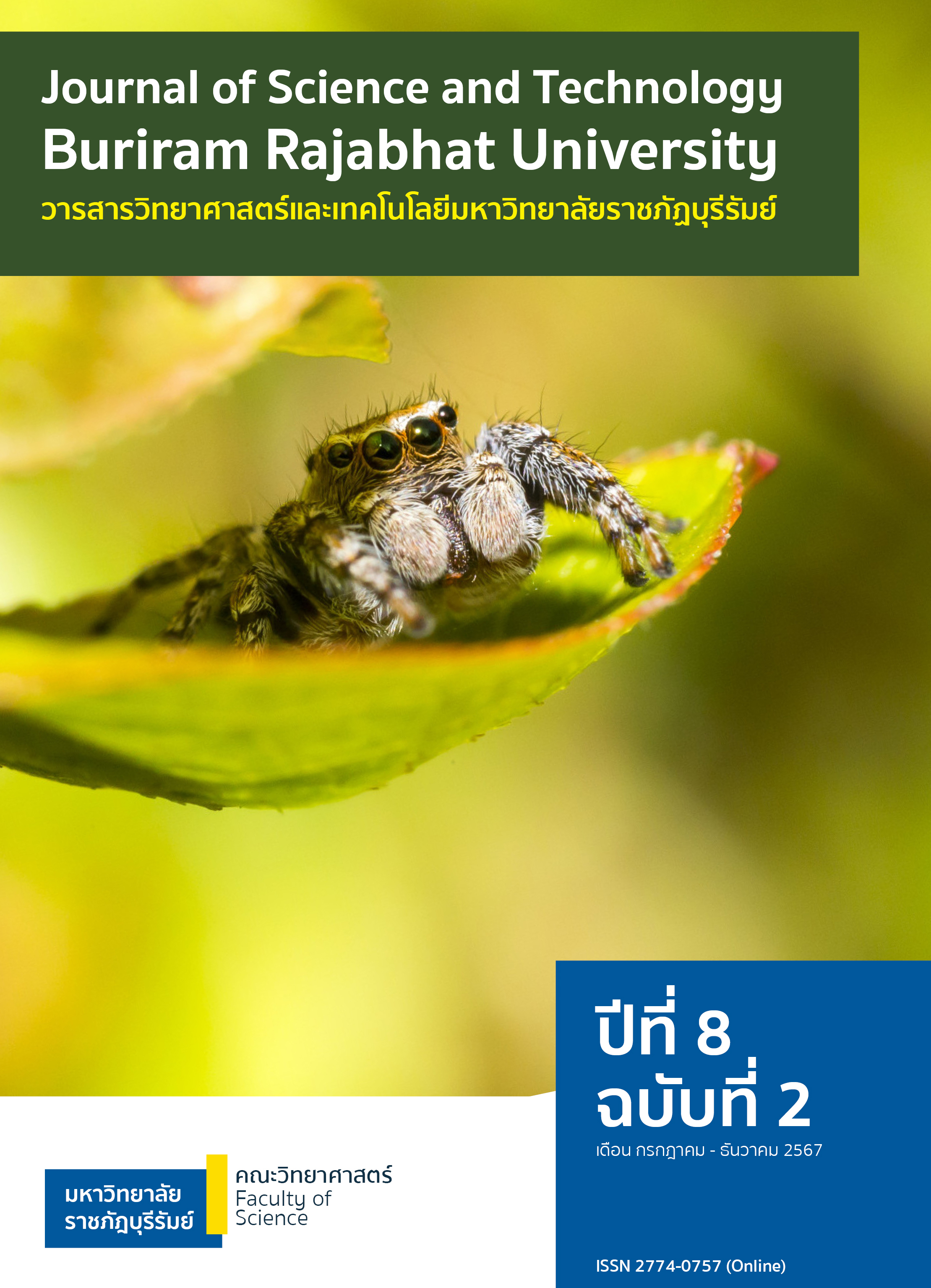การเพิ่มประสิทธิภาพอิเล็กโทรด SPCE ด้วยอนุภาคนาโนของทองคำและแพลทินัมเพื่อปรับปรุงการตรวจจับภาวะเครียดจากปฏิกิริยาออกซิเดชัน
Main Article Content
บทคัดย่อ
งานวิจัยนี้มุ่งเน้นการสังเคราะห์อนุภาคนาโนทองคำและแพลทินัมเพื่อปรับปรุงขั้วไฟฟ้า SPCE สำหรับใช้ในการพัฒนาเทคนิคไซคลิกโวลแทมเมทรีเพื่อตรวจจับภาวะเครียดออกซิเดชันในอนาคต โดยผลการวิเคราะห์ด้วยภาพจากกล้องอิเล็กตรอนแบบส่องผ่าน (Transmission Electron Microscopy: TEM) แสดงขนาดอนุภาคที่ค่าเฉลี่ย 6.4 นาโนเมตร และผลทดสอบด้วยเทคนิควิเคราะห์การเลี้ยวเบนของรังสีเอ็กซ์ (X-ray Diffractometer: XRD) แสดงตำแหน่งการเลี้ยวเบนของอนุภาคนาโนทองคำและแพลทินัมที่ 2 theta ประมาณ 38.1°, 44.4°, 64.8°, 77.6° และ 81.8° ซึ่งตำแหน่งสุดท้ายเป็นของแพลทินัม หลังจากการสังเคราะห์ อนุภาคนาโนถูกชุบไฟฟ้าลงบนขั้วไฟฟ้า SPCE โดยใช้สารละลายโพแทสเซียมคลอไรด์ (Potassium chloride: KCl) ผสมกับอนุภาคนาโนทองคำและแพลทินัมที่ให้กระแสไฟฟ้า -0.25 โวลต์, -0.5 โวลต์, -0.75 โวลต์ และ -1 โวลต์ ผลการทดสอบด้วยรามานสเปกโทรสโคปี พบพีคที่ 1200-1450 cm-¹ และ 1500-1600 cm-¹ ซึ่งเป็นพีคของคาร์บอน ทองคำและแพลทินัมที่ทับซ้อนกัน การทดสอบด้วยเทคนิคกล้องอิเล็กตรอนแบบส่องกราด (Scanning Electron Microscopy: SEM) แสดงลักษณะอนุภาคนาโนทองคำและแพลทินัมที่ชัดเจน เมื่อทดสอบขั้วไฟฟ้าที่ชุบไฟฟ้าด้วยเทคนิค ไซคลิกวอลเทมเมตรี พบว่าการชุบที่กระแสไฟฟ้า -0.25 โวลต์ ให้สัญญาณที่ปรับปรุงชัดเจนที่สุดเมื่อเทียบกับกระแสไฟฟ้าอื่นๆ รวมถึงขั้วไฟฟ้าที่ไม่ได้ปรับปรุง การศึกษานี้สรุปว่าการใช้อนุภาคนาโนทองคำและแพลทินัมสามารถปรับปรุงสัญญาณของขั้วไฟฟ้า SPCE ได้อย่างมีนัยสำคัญ ซึ่งสามารถนำไปใช้ในงานวิจัยการตรวจจับภาวะเครียดออกซิเดชันในอนาคต
Article Details

อนุญาตภายใต้เงื่อนไข Creative Commons Attribution-NonCommercial-NoDerivatives 4.0 International License.
เนื้อหาและข้อมูลในบทความที่ลงตีพิมพ์ในวารสารวารสารวิทยาศาสตร์และเทคโนโลยีถือเป็นข้อคิดเห็นและความรับผิดชอบของผู้เขียนบทความโดยตรงซึ่งกองบรรณาธิการวารสาร ไม่จำเป็นต้องเห็นด้วย หรือร่วมรับผิดชอบใด ๆ
บทความ ข้อมูล เนื้อหา รูปภาพ ฯลฯ ที่ได้รับการตีพิมพ์ในวารสารวารสารวิทยาศาสตร์และเทคโนโลยีถือเป็นลิขสิทธิ์ของวารสารวารสารวิทยาศาสตร์และเทคโนโลยีหากบุคคลหรือหน่วยงานใดต้องการนำทั้งหมดหรือส่วนหนึ่งส่วนใดไปเผยแพร่ต่อหรือเพื่อกระทำการใด ๆ จะต้องได้รับอนุญาตเป็นลายลักษณ์อักษรจากวารสารวารสารวิทยาศาสตร์และเทคโนโลยี ก่อนเท่านั้น
เอกสารอ้างอิง
Chen, R., Wu, S., & Meng, C. (2021). Size-tunable green synthesis of platinum nanoparticles using chlorogenic acid. Research on Chemical Intermediates, 47(5), 1775-1787. https://doi.org/10.1007/s11164-020-04377-4
Chen, R., Yi, G., Wu, S., & Meng, C. (2021). Controlled green synthesis of Au–Pt bimetallic nanoparticles using chlorogenic acid. Research on Chemical Intermediates, 47(10), 4051-4066. https://doi.org/10.1007/s11164-021-04513-8
Dechtrirat, D., Yingyuad, P., Prajongtat, P., Chuenchom, L., Sriprachuabwong, C., Tuantranont, A., & Tang, I. M. (2018). A screen-printed carbon electrode modified with gold nanoparticles, poly(3,4-ethylenedioxythiophene), poly(styrene sulfonate) and a molecular imprint for voltammetric determination of nitrofurantoin. Microchimica Acta, 185(5), 261. https://doi.org/10.1007/s00604-018-2797-3
Dheyab, M., Abdul Aziz, A., Jameel, M., Moradi Khaniabadi, P., & Oglat, A. (2020). Rapid Sonochemically-Assisted Synthesis of Highly Stable Gold Nanoparticles as Computed Tomography Contrast Agents. Applied Sciences, 10, 7020. https://doi.org/10.3390/app10207020
Elgrishi, N., Rountree, K. J., McCarthy, B. D., Rountree, E. S., Eisenhart, T. T., & Dempsey, J. L. (2018). A Practical Beginner’s Guide to Cyclic Voltammetry. Journal of Chemical Education, 95(2), 197-206.
https://doi.org/10.1021/acs.jchemed.7b00361
Faradilla, P., Setiyanto, H., Manurung, R. V., & Saraswaty, V. (2022). Electrochemical sensor based on screen printed carbon electrode–zinc oxide nano particles/molecularly imprinted-polymer (SPCE–ZnONPs/MIP) for detection of sodium dodecyl sulfate (SDS) [10.1039/D1RA06862H]. RSC Advances, 12(2), 743-752. https://doi.org/10.1039/D1RA06862H
Holder, C. F., & Schaak, R. E. (2019). Tutorial on powder X-ray diffraction for characterizing nanoscale materials. In (Vol. 13, pp. 7359-7365): ACS Publications.
Khalil, M., Mostafa, Y., & torad, E. (2014). Biosynthesis and characterization of Pt and Au-Pt nanoparticles and their photo catalytic degradation of methylene blue. International Journal of Advanced Research, 2, 694-703.
Kumar, M., Boddeti, G., & Annapurna, N. (2017). Green Synthesis and Characterization of Platinum Nanoparticles using Sapindus mukorossi Gaertn. Fruit Pericarp. Asian Journal of Chemistry, 29, 2541-2544. https://doi.org/10.14233/ajchem.2017.20842A
Lee, C.-F., Chang, C.-L., Yang, J.-C., Lai, H.-Y., & Chen, C.-H. (2012). Morphological determination of face-centered-cubic metallic nanoparticles by X-ray diffraction. Journal of Colloid and Interface Science, 369(1), 129-133. https://doi.org/https://doi.org/10.1016/j.jcis.2011.12.053
Li, Z., Deng, L., Kinloch, I. A., & Young, R. J. (2023). Raman spectroscopy of carbon materials and their composites: Graphene, nanotubes and fibres. Progress in Materials Science, 135, 101089.
https://doi.org/https://doi.org/10.1016/j.pmatsci.2023.101089
Lisnund, S., Blay, V., Muamkhunthod, P., Thunyanon, K., Pansalee, J., Monkrathok, J., Maneechote, P., Chansaenpak, K., & Pinyou, P. (2022). Electrodeposition of Cobalt Oxides on Carbon Nanotubes for Sensitive Bromhexine Sensing. Molecules, 27(13), 4078.
Liu, Y., Liu, C., Xin, Y., Liu, P., Xiao, A., & Ling, Z. (2024). A Signal-Based Auto-Focusing Method Available for Raman Spectroscopy Acquisitions in Deep Space Exploration. Remote Sensing, 16(5), 820. https://www.mdpi.com/2072-4292/16/5/820
Mavukkandy, M., Chakraborty, S., Abbasi, T., & Abbasi, S. A. (2016). A clean-green synthesis of platinum nanoparticles utilizing a pernicious weed lantana (Lantana camara). 9, 84-90. https://doi.org/10.3844/ajeassp.2016.84.90
Mourdikoudis, S., Pallares, R. M., & Thanh, N. T. (2018). Characterization techniques for nanoparticles: comparison and complementarity upon studying nanoparticle properties. Nanoscale, 10(27), 12871-12934.
Parcharoen, M. Y. (2014 ). Electrodepositlon of hydroxyapatite and graphene oxide on anodized tatanium for orthopedic applications.
Ren, B., Liu, G. k., Lian, X.-B., Yang, Z., & Tian, Z.-Q. (2007). Raman spectroscopy on transition metals. Analytical and bioanalytical chemistry, 388, 29-45. https://doi.org/10.1007/s00216-007-1141-2
Sies, H., Berndt, C., & Jones, D. P. (2017). Oxidative stress. Annual review of biochemistry, 86, 715-748.
Sneha, K., Esterle, A., Sharma, N., & Sahi, S. (2014). Yucca-derived synthesis of gold nanomaterial and their catalytic potential. Nanoscale research letters, 9, 627. https://doi.org/10.1186/1556-276X-9-627
Storz, G., & Imlayt, J. A. (1999). Oxidative stress. Current Opinion in Microbiology, 2(2), 188-194. https://doi.org/https://doi.org/10.1016/S1369-5274(99)80033-2
Wang, J., Xu, S., Sun, P., Du, H., & Wang, L. (2022). Enhanced electrochemical performance of screen-printed carbon electrode by RF-plasma-assisted polypyrrole modification. Journal of Materials Science: Materials in Electronics, 33(25), 19923-19936. https://doi.org/10.1007/s10854-022-08811-8
Weichun Ye, H. K., Qinze Liu, Junfeng Yan, Feng Zhou, Chunming Wang. (2012). Electrochemical deposition of Au–Pt alloy particles with cauliflower-like microstructures for electrocatalytic methanol oxidation. Elsevier Science. https://doi.org/10.1016/j.ijhydene.2011.11.132


